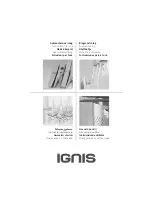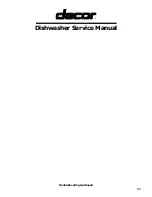
Page 11
ASKO Advisory Center Phone Number:
972-238-0794 or 800-898-1879
TR
TR
TR
TR
TROUBLESHOO
OUBLESHOO
OUBLESHOO
OUBLESHOO
OUBLESHOOTING
TING
TING
TING
TING
If you should experience a problem with your dishwasher,
you should review the list of frequently encountered
situations below. It could save you the cost and
inconvenience of a service call.
Even though the product is under warranty, if the problem
is not caused by defective product workmanship or
materials, you will be charged for a service call. Refer to
page 15 to determine what is and is not covered under
your warranty. If you’re still not sure, contact the ASKO
Advisory Center before you call a service technician.
BEFORE
BEFORE
BEFORE
BEFORE
BEFORE Y
Y
Y
Y
YOU CALL
OU CALL
OU CALL
OU CALL
OU CALL
Before calling for service or contacting ASKO regarding
a warranty issue, make a note of the model name, type
number and serial number. The model is on the front of
the dishwasher. The type plate with the type name and
serial number is located on the inside edge of the door.
(See illustration at right.)
Type plate
(see below)
Type: DW20.x
000000000000
123456789012345678
123456789012345678
123456789012345678
Type Name
12-digit
Serial
Number
Detergent left in compartment
♦
Be careful not to load items so close to the dispenser
that the cover will not open to release the detergent.
♦
The dispenser is not supposed to open when you
use the Rinse program.
♦
Your dishwasher detergent should be fresh and stored
tightly closed in a cool, dry place. Old or caked
detergent should be thrown away because it will not
dissolve properly and will leave a gritty residue on
the dishware.
♦
Wait until you are ready to start the dishwasher to
add the detergent.
♦
The detergent compartment only opens in the main
wash programs, not the Rinse program.
Dishwasher makes unusual noises
♦
This usually means that something is not loaded
properly. Make sure the dishes are securely in place
and that nothing has fallen between the basket tines.
Also, place small items in the small items
compartment and close the lid. (See page 4.)
Dishwasher leaks
♦
Use only unscented, granular automatic dishwasher
detergent. Using a liquid detergent could cause
oversudsing and leakage.
♦
You should always use fresh detergent.
♦
The amount of detergent needed for your dishes
depends on the hardness of the water in your area.
Contact your local utility company to learn the water
hardness in your area then refer to the chart on page
5 to determine the amount of detergent you should
use.
♦
Be careful not to overfill the rinse aid dispenser.
Spilled rinse aid could cause oversudsing and lead
to overflowing. Wipe away any spills with a damp
cloth.
♦
Make sure the dishwasher is level. (See the
installation instructions.)
Dishwasher runs too long
♦
If the temperature of the water entering your dishwasher
is below 120°, the dishwasher runs longer because it
heats the water to the proper temperature for the
program selected. Raising your water heater setting
may help to shorten the cycle times. If this doesn’t
resolve the problem, call the ASKO Advisory Center.
Continued on next page.
To remove hard water spots, try the following:
1. Run dishes through a normal wash program.
2. Remove all metal dishware, such as cutlery, pans,
etc., from the dishwasher.
3. Do not add detergent.
REMO
REMO
REMO
REMO
REMOVING HARD
VING HARD
VING HARD
VING HARD
VING HARD WA
WA
WA
WA
WATER SPO
TER SPO
TER SPO
TER SPO
TER SPOTS FR
TS FR
TS FR
TS FR
TS FROM DISHES
OM DISHES
OM DISHES
OM DISHES
OM DISHES
4. Pour two cups of vinegar into a bowl and set the
bowl face up on the bottom rack of the dishwasher.
5. Run the dishes through a Normal wash program.
If this doesn’t work, try the same process with 1/4 cup of
citric acid crystals (available at most drug stores) instead
of vinegar.
Содержание D3112
Страница 16: ...Page 16 Art no 8077166 Rev 01 ...


































